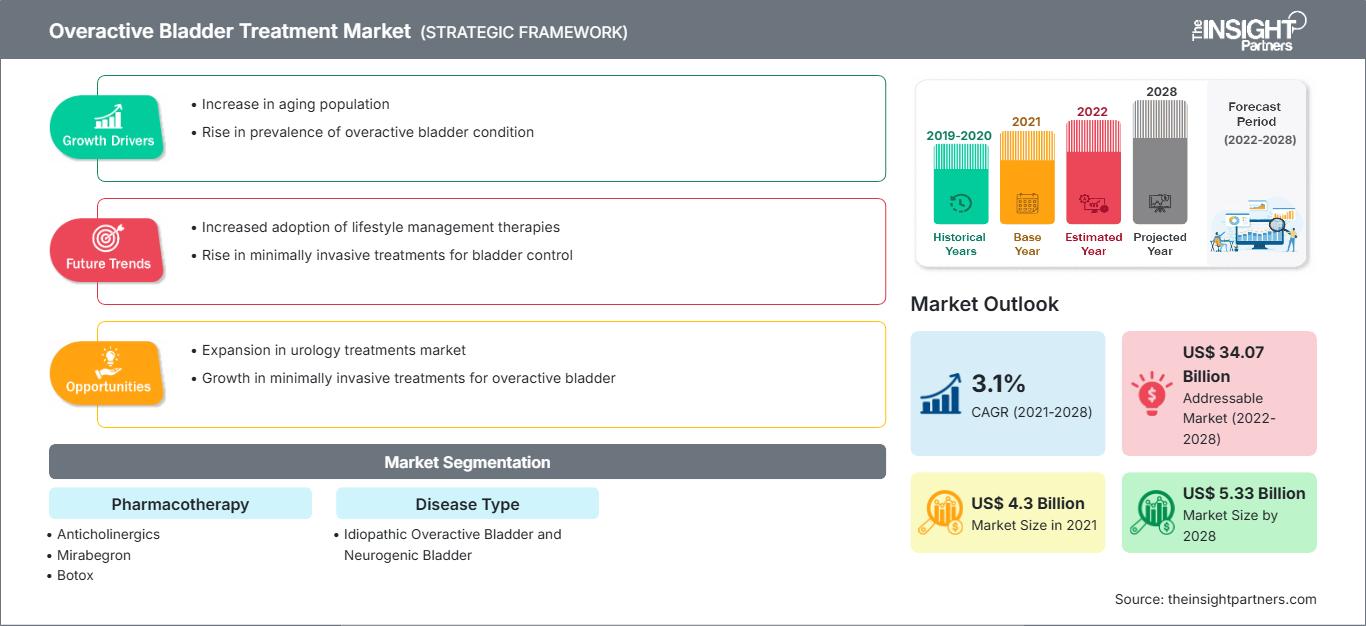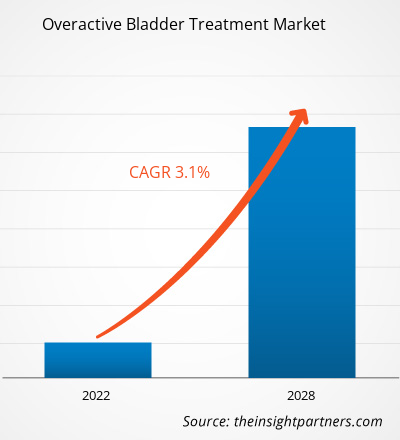Der Markt für die Behandlung einer überaktiven Blase soll von 4.295,93 Millionen US-Dollar im Jahr 2021 auf 5.333,92 Millionen US-Dollar im Jahr 2028 wachsen; von 2022 bis 2028 wird ein CAGR von 3,1 % geschätzt.
Eine überaktive Blase (OAB) ist ein häufiger und plötzlicher Harndrang, der schwer zu kontrollieren sein kann. OAB kann durch Bauchtraumata, Infektionen, Nervenschäden und bestimmte Medikamente verursacht werden. OAB tritt häufig bei Menschen ab 65 Jahren auf. Frauen können auch nach dem 45. Lebensjahr noch an OAB leiden. Die Behandlung umfasst Verhaltensänderungen, Medikamente und Nervenstimulation.
Der Markt für die Behandlung einer überaktiven Blase ist nach Pharmakotherapie, Krankheitstyp und Geografie segmentiert. Geografisch ist der Markt grob in Nordamerika, Europa, Asien-Pazifik, den Nahen Osten und Afrika sowie Süd- und Mittelamerika unterteilt. Der Marktbericht zur Behandlung der überaktiven Blase bietet Einblicke und eine eingehende Analyse des Marktes und betont Parameter wie Markttrends, Marktdynamik und die Wettbewerbsanalyse der weltweit führenden Marktteilnehmer.
Passen Sie diesen Bericht Ihren Anforderungen an
Sie erhalten kostenlos Anpassungen an jedem Bericht, einschließlich Teilen dieses Berichts oder einer Analyse auf Länderebene, eines Excel-Datenpakets sowie tolle Angebote und Rabatte für Start-ups und Universitäten.
Markt für die Behandlung überaktiver Blasen: Strategische Einblicke

-
Holen Sie sich die wichtigsten Markttrends aus diesem Bericht.Dieses KOSTENLOSE Beispiel umfasst Datenanalysen, die von Markttrends bis hin zu Schätzungen und Prognosen reichen.
Markteinblicke
Laut Daten der National Association for Incontinence litten im Jahr 2018 weltweit rund 200 Millionen Menschen an Harninkontinenz. Belastungsinkontinenz und Dranginkontinenz sind die beiden häufigsten Formen der Harninkontinenz bei Frauen, wobei letztere auch als überaktive Blase bezeichnet wird. Eine Studie einer Forschergruppe des American College of Physicians und der Infectious Diseases Society of America aus dem Jahr 2020 ergab, dass Harnwegsinfektionen (HWI) in den USA jährlich für rund 6 Millionen Arztbesuche verantwortlich sind. In Kanada erfolgen jährlich rund 500.000 Arztbesuche wegen HWI. HWI sind der acht- bzw. fünfthäufigste Grund für Besuche in der Ambulanz bzw. Notaufnahme im Land. Die zunehmende Verbreitung von Harninkontinenz und die steigende Zahl von Harnwegsinfektionen treiben den Markt für die Behandlung überaktiver Blasen an.
Nachfolgend einige Beispiele für die Markteinführung und Zulassung neuer Produkte:
- Im Februar 2022 erhielt Alembic Pharmaceuticals von der US-Gesundheitsbehörde die Zulassung für seine generische Version von Fesoterodinfumarat-Retardtabletten zur Behandlung überaktiver Blasen bei Erwachsenen mit Symptomen von Harninkontinenz, Harndrang und häufigem Harnlassen. Die Zulassung der US-amerikanischen Food & Drug Administration (USFDA) für den verkürzten Zulassungsantrag (ANDA) für Fesoterodinfumarat-Retardtabletten gilt für die Stärken 4 mg und 8 mg.
- Im April 2022 kündigte Axonics, Inc. – ein globales Medizintechnikunternehmen, das neuartige Produkte zur Behandlung von Blasen- und Darmfunktionsstörungen entwickelt und vermarktet – die flächendeckende Markteinführung des Axonics F15 in den USA an. Das neu entwickelte, langlebige und vollständig wiederaufladbare System zur sakralen Neuromodulation (SNM) erhielt im März die FDA-Zulassung. Das aufladefreie System von Axonics ist eine willkommene Weiterentwicklung für Patienten mit Blasen- und Darmfunktionsstörungen.
- Im März 2021 wurden Myrbetriq von Astellas Pharma – zur Behandlung der neurogenen Detrusorüberaktivität (NDO) bei pädiatrischen Patienten ab drei Jahren (mit einem Körpergewicht von 35 kg oder mehr) – und Myrbetriq Granules – zur Behandlung von NDO bei pädiatrischen Patienten ab drei Jahren – von der US-amerikanischen Food and Drug Administration (FDA) zugelassen.
Solche Produktentwicklungen von Marktteilnehmern treiben den Markt für die Behandlung der überaktiven Blase voran.
Typ-Einblicke
Basierend auf der Pharmakotherapie ist der Markt für die Behandlung der überaktiven Blase in Mirabegron, Botox, Neurostimulation, Anticholinergika und intravesikale Instillation unterteilt. Das Segment Mirabegron hatte 2021 den größten Marktanteil und dürfte im Prognosezeitraum die höchste durchschnittliche jährliche Wachstumsrate (CAGR) verzeichnen. Mirabegron wird allein oder in Kombination mit Solifenacin zur Behandlung einer überaktiven Blase bei Erwachsenen angewendet. Es wird zur Behandlung einer neurogenen Detrusorüberaktivität (eine Blasenkontrollstörung, die durch ein Problem des Gehirns, des Rückenmarks oder der Nerven verursacht wird) bei Kindern ab drei Jahren eingesetzt. Mirabegron gehört zur Klasse der Beta-3-Adrenozeptoragonisten. Es entspannt die Blasenmuskulatur und beugt so dringendem, häufigem oder unkontrolliertem Wasserlassen vor. Mirabegron ist als Retardtablette (lang wirkend) und als Retardsuspension zum Einnehmen erhältlich. Im Oktober 2022 erhielt Zydus Pharmaceuticals Inc. von der US-amerikanischen Arzneimittelbehörde FDA die Zulassung zur Vermarktung von Mirabegron-Retardtabletten USP 25 mg und 50 mg. Die steigende Nachfrage nach dieser Therapie dürfte das Wachstum des Marktes für die Behandlung überaktiver Blasen im Prognosezeitraum ankurbeln.
Service-Einblicke
Basierend auf der Pharmakotherapie ist der Markt für die Behandlung überaktiver Blasen in die Segmente Mirabegron, Botox, Neurostimulation, Anticholinergika und intravesikale Instillation unterteilt. Das Segment Neurostimulation wird im Prognosezeitraum voraussichtlich die höchste durchschnittliche jährliche Wachstumsrate (CAGR) auf dem Markt verzeichnen. Die neurologische Kontrolle der Blase ist komplex und hängt von verschiedenen spinalen, zentralen und peripheren Nerven und ihren zahlreichen Reflexbahnen ab. Die neurologische Kontrolle wird an verschiedenen Stellen des menschlichen Körpers durchgeführt und zielt daher auf verschiedene Nerven ab. Einige dieser Zielnerven sind direkt an der sensorischen und motorischen Kontrolle der unteren Harnwege beteiligt, wie z. B. die Sakral- oder Pudendusnerven, während andere eher indirekt beteiligt sind. Durch elektrische Stimulation werden diese Nerven aktiviert, um die Blase zu kontrollieren.
Partnerschaften und Kooperationen sind häufig genutzte Strategien der globalen Akteure auf dem Markt für die Behandlung überaktiver Blasen. Einige der wichtigsten Marktentwicklungen der letzten Zeit sind nachfolgend aufgeführt:
- Im April 2021 gab Medtronic plc die Genehmigung der US-amerikanischen Food and Drug Administration (FDA) bekannt, mit einer Investigational Device Exemption (IDE)-Studie fortzufahren, um sein intern entwickeltes implantierbares Gerät zur Tibia-Neuromodulation (TNM) zu evaluieren, eine Therapie zur Linderung der Symptome von Blaseninkontinenz.
- Im Juli 2020 gab Hisamitsu Pharmaceutical Co., Inc. die Genehmigung zur Herstellung und Vermarktung von OABLOK PATCH in Thailand bekannt. Das Produkt ist eine systemische transdermale Formulierung, die unter Verwendung der Transdermal Drug Delivery System (TDDS)-Technologie von Hisamitsu zur Behandlung einer überaktiven Blase mit Symptomen wie Harndrang und häufigem Wasserlassen entwickelt wurde.
- Im Juli 2019 brachte Teva Pharmaceuticals Ltd. Solifenacinsuccinat-Tabletten auf den Markt, Muskarinantagonisten zur Behandlung einer überaktiven Blase mit Symptomen von Harninkontinenz und häufigerem Wasserlassen.
Die COVID-19-Pandemie hat einige günstige Szenarien für Akteure auf dem Markt für die Behandlung einer überaktiven Blase gezeigt. Die USA waren das am stärksten betroffene Land in Nordamerika. Die Infektion traf die geriatrische Bevölkerung des Landes schwer, verursachte verschiedene Komplikationen und führte zum Tod eines großen Teils der Bevölkerung. Beispielsweise meldeten die USA am 16. Mai 2022 84.230.829 COVID-Fälle mit 1.026.670 Todesfällen. Daher sind eine Behandlung der überaktiven Blase und die richtige Pflege erforderlich, um chronischen Infektionen und Gesundheitsproblemen vorzubeugen.
Nach dem Ausbruch von COVID-19 kam es vermehrt zu Fällen von überaktiver Blase. Einer Studie der American Urological Association zufolge besteht bei Patienten mit COVID-19-Infektionen ein erhöhtes Risiko, neue oder sich verschlimmernde Symptome einer überaktiven Blase zu entwickeln. Zudem berichtete etwa ein Drittel der Patienten mit COVID-19 im Rahmen des International Consultation on Incontinence Questionnaire Overactive Bladder Module (ICIQ-OAB), das zwei Monate nach der Infektion durchgeführt wurde, von einer signifikanten Zunahme der klinischen Symptome. Von diesem Drittel der Patienten gab etwa jeder Fünfte an, dass seine OAB-Symptome neu aufgetreten seien. Diese erhöhte Prävalenz von OAB aufgrund von COVID-19 wirkte sich positiv auf die Nachfrage nach Behandlungen für überaktive Blasen während der Pandemie aus.
Behandlung der überaktiven Blase
Regionale Einblicke in den Markt für die Behandlung überaktiver BlasenDie Analysten von The Insight Partners haben die regionalen Trends und Faktoren, die den Markt für die Behandlung überaktiver Blasen während des Prognosezeitraums beeinflussen, ausführlich erläutert. In diesem Abschnitt werden auch die Marktsegmente und die geografische Lage in Nordamerika, Europa, dem asiatisch-pazifischen Raum, dem Nahen Osten und Afrika sowie Süd- und Mittelamerika erörtert.
Umfang des Marktberichts zur Behandlung überaktiver Blasen
| Berichtsattribut | Einzelheiten |
|---|---|
| Marktgröße in 2021 | US$ 4.3 Billion |
| Marktgröße nach 2028 | US$ 5.33 Billion |
| Globale CAGR (2021 - 2028) | 3.1% |
| Historische Daten | 2019-2020 |
| Prognosezeitraum | 2022-2028 |
| Abgedeckte Segmente |
By Pharmakotherapie
|
| Abgedeckte Regionen und Länder |
Nordamerika
|
| Marktführer und wichtige Unternehmensprofile |
|
Dichte der Marktteilnehmer im Bereich Behandlung überaktiver Blase: Verständnis ihrer Auswirkungen auf die Geschäftsdynamik
Der Markt für Behandlungen der überaktiven Blase wächst rasant. Dies wird durch die steigende Nachfrage der Endverbraucher aufgrund veränderter Verbraucherpräferenzen, technologischer Fortschritte und eines stärkeren Bewusstseins für die Produktvorteile vorangetrieben. Mit der steigenden Nachfrage erweitern Unternehmen ihr Angebot, entwickeln Innovationen, um den Bedürfnissen der Verbraucher gerecht zu werden, und nutzen neue Trends, was das Marktwachstum weiter ankurbelt.

- Holen Sie sich die Markt für die Behandlung überaktiver Blasen Übersicht der wichtigsten Akteure
Behandlung der überaktiven Blase – Marktsegmentierung
Der globale Markt für die Behandlung der überaktiven Blase wird anhand von Pharmakotherapie, Krankheitstyp und Geografie analysiert. Basierend auf der Pharmakotherapie wird der Markt für die Behandlung der überaktiven Blase in Mirabegron, Botox, Neurostimulation, Anticholinergika und intravesikale Instillation unterteilt. Basierend auf dem Krankheitstyp wird der Markt in idiopathische überaktive Blase und neurogene Blase unterteilt.
Geographisch ist der Markt für die Behandlung der überaktiven Blase in Nordamerika, Europa, Asien-Pazifik, den Nahen Osten und Afrika sowie Süd- und Mittelamerika segmentiert.Firmenprofile
- Alembic Pharmaceuticals Limited
- Astellas Pharma Inc
- AbbVie Inc
- Teva Pharmaceuticals Industries Ltd
- Endo Pharmaceuticals Inc
- Hisamitsu Pharmaceutical Co. Inc
- Medtronic Plc
- Colorado Urology Associates, PLLC
- Axonics Modulation Technologies, Inc
- Pfizer Inc
- Historische Analyse (2 Jahre), Basisjahr, Prognose (7 Jahre) mit CAGR
- PEST- und SWOT-Analyse
- Marktgröße Wert/Volumen – Global, Regional, Land
- Branchen- und Wettbewerbslandschaft
- Excel-Datensatz
Aktuelle Berichte
Erfahrungsberichte
Grund zum Kauf
- Fundierte Entscheidungsfindung
- Marktdynamik verstehen
- Wettbewerbsanalyse
- Kundeneinblicke
- Marktprognosen
- Risikominimierung
- Strategische Planung
- Investitionsbegründung
- Identifizierung neuer Märkte
- Verbesserung von Marketingstrategien
- Steigerung der Betriebseffizienz
- Anpassung an regulatorische Trends






















 Kostenlose Probe anfordern für - Markt für die Behandlung überaktiver Blasen
Kostenlose Probe anfordern für - Markt für die Behandlung überaktiver Blasen